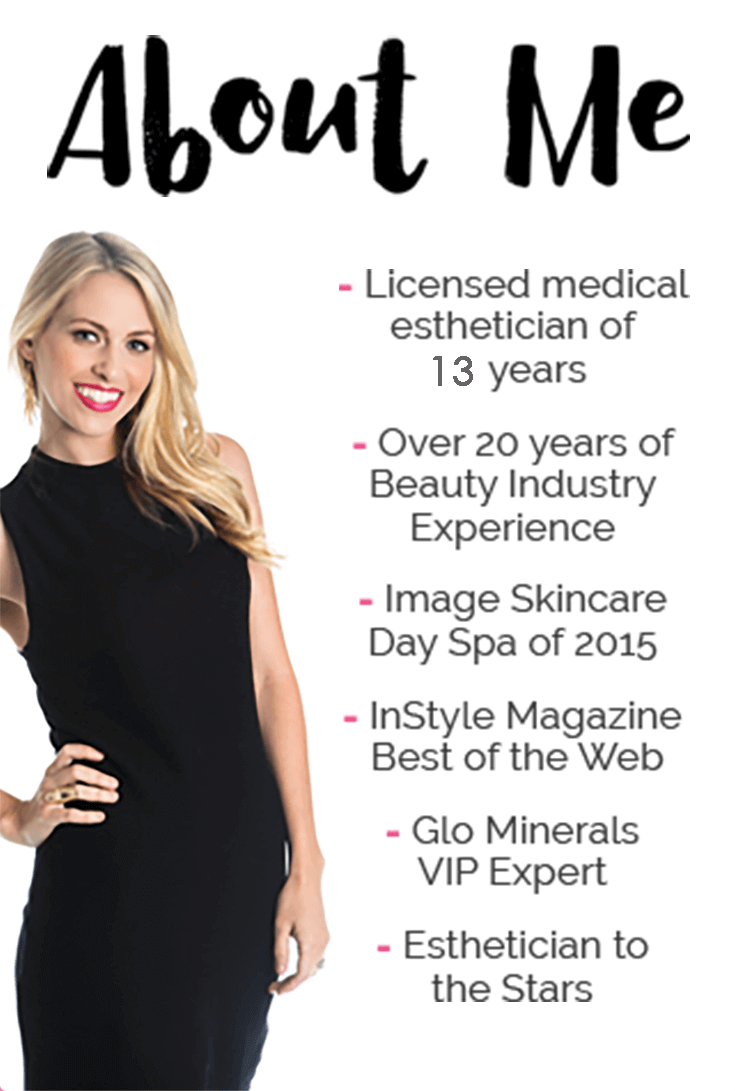What Should You Be Using In Your Skin Care Routine?
Take my quiz and get personalized recommendations from a
licensed esthetician!
Is Dry Brushing the Stimulation Our Skin Needs?
We all have skin conditions that we'd love to have disappear instantly, like scars and stretch marks.
Cellulite is one of the most common skin complaints I hear from women.
"I feel like I've tried everything! Why can't it just go away?"
Well, ladies, we're not alone.

Trends that claim to banish cellulite have come and gone.
Right now, though, we have two that are currently in the spotlight: dry brushing and the FasciaBlaster.
Never heard of them?
That's OK, I'm here to explain!
A quick Google search will reveal their popularity.
You might be wondering if all the info, testimonials, and reviews are an indication that we may actually have found a fix for cellulite.
I'm revealing all of that and more in today's blog post!

What is Dry Brushing?
Made popular by some celebrities in recent years (hello, Gywenth Paltrow), many people have embraced dry brushing as a part of their skincare routine.
Lately, I'm pleased to see more women and men taking care of the skin on their body with regular maintenance - not just their face.
Essentially, what you need to know about dry brushing is in the name - a dry brush is moved over the body in slow, circular motions several times a week to deliver a rejuvenating combo of exfoliation and massage.
It's said that the firm brush bristles slough off dead skin for thorough exfoliation while the pressure stimulates circulation and promotes lymphatic drainage.
This lymphatic drainage is why so many people have spoken out about dry brushing and helped boost its popularity - but is lymphatic drainage even necessary?
Don't our bodies already do that on their own?
What is Lymphatic Drainage?
According to the National Lymphedema Network, the lymphatic system functions parallel to the circulatory system and is made up of lymph nodes, lymph vessels, and lymphoid tissues.
It's also a major part of the body's immune system.
Lymph fluid is transported to lymph nodes that act as "filtering" stations in the body that help fight bacteria and viruses.
A healthy lymphatic system uses smooth muscle tissue contractions to move lymph fluid around.
However, surgery (most often cancer removal) can cause fluids to build up in your lymph nodes, which is a condition known as lymphedema.
A doctor may recommend a lymphatic drainage massage for those who have had surgery.
Fans of dry brushing claim that it stimulates normal lymph fluid flow and helps the body detoxify itself naturally - but your body doesn't (usually) need any help with this!
You don't need to worry about "slow lymphatic flow" you may see on some websites, despite the health claims.

Other Benefits of Dry Brushing
There is some truth to the health and beauty claims made about dry brushing, which I'll explain below:
Exfoliation
Dry brushing is a type of physical exfoliant.
You may notice results right after trying dry brushing for the first time as it loosens and removes dead skin cells to reveal soft, smooth skin.
(Let's be real, so many of us don't exfoliate our body as much as we exfoliate our face!)
An Invigorating Feeling
Many people have reported an energy boost after dry brushing due to the stimulation of blood flow.
This helps deliver oxygenated blood and nutrients to the skin and other organs.
Because of this, dry brushing is recommended as a part of your morning skincare routine (before showering).

So, Does Dry Brushing Work?
As I mentioned before, many people are either interested in trying dry brushing or already have in the hopes that it can eliminate cellulite.
As with many things we read on the Internet, a lot of claims about the benefits of dry brushing haven't been researched or are just flat-out untrue.
Dry brushing isn't the cure-all it's been positioned as, nor should it be considered a medical treatment.
At best, dry brushing helps smooth the appearance of cellulite due to temporary plumping, not get rid of it.
When adopted as part of your skincare routine, it can soften skin and is a good method of exfoliation.
Some have reported firmer skin and reduced stretch marks in the long run.
The Details
If you're still interested in trying dry brushing for its exfoliating abilities, I'll show you how it's done!
First, you'll need a high-quality body brush.
I recommend one with a handle for those hard-to-reach areas.
Many dry bushing supporters say they've started with a soft bristle brush and then purchased a firm bristle brush after they built up a tolerance.
I would recommend starting on the softer side and working your way up with firmness over time, especially if your skin is sensitive.
To find a brush, I suggest searching on Amazon and reading reviews, visiting your local day spa and asking for recommendations, or consulting your esthetician.
The only drawback to ordering on Amazon is that you can't feel the bristles first.
As for natural or synthetic bristles, the choice is yours.
Again, many supporters say they prefer natural bristles, which may include boar bristle or plant-based fibers, for their ability to distribute your skin's natural oils and lessen the risk of irritation.
As for how often you should dry brush, I say it depends on personal needs and preference.
Some people only do 2-3 times a week; others do twice a day after working up to it.
Just please don't brush too hard!
A soft and smooth stroke often works best.
If it hurts at all, use less pressure!
Your skin may be slightly pink after brushing, but it should never be red or sting.
If you notice any peeling or bruising, take a break for a few days.
Brush Maintenance
Depending on usage amount, replace your brush every 6-12 months as the bristles will eventually wear out.
I also recommend washing your brush with fragrance-free soap and warm water once a week to remove dead skin cells.
Leave in a clean, dry spot to dry to avoid mildew.
Side note: I've only been referring to dry brushing the skin on your body. Many people dry brush their face. I would err on the side of caution and use an electric cleansing brush for the face or a chemical exfoliant, like fruit acids.
How to Dry Brush
Dedicate 3-5 minutes for brushing.
I recommend standing in the shower so you don't get dead skin on your floor (gross, I know).
- Start at your feet and move up your legs in circular, smooth strokes.
- When brushing, it's OK to overlap and go over areas again.
- Begin on your hands and move up your arms.
- Take care as you brush over more sensitive areas. For your stomach and armpits, brush gently in a counterclockwise pattern.
- Shower, then follow with lotion or body oil. I recommend jojoba, rosehip, or coconut oil.

What In the World is Fascia?
If this is the first time you've ever heard about fascia, I'm not surprised!
It's been given more attention in recent years.
Our muscles and tissues are enveloped and joined by an interconnected tissue network called fascia.
It's been described as a "plastic wrap around your muscles" or like "the white, fibrous layer of an orange peel."
Researchers are still trying to figure out exactly what fascia is.
According to Dr. Charles Kim, assistant professor at NYU Langone's Center for Musculoskeletal Care, some people get adhesions to fascia and tissue, which can cause pain.
Physical therapists use myofascial (which means muscle and fascia) release, which includes friction and trigger points, to break up the fascia tension.
Other examples of myofascial release are using a foam roller at the gym, deep tissue massage, and stretching daily.
If your pain is sudden, talk to your doctor to make sure it's not an injury.
If you're thinking, "But I'm not experiencing soreness; I just want to know more about cellulite," keep on reading!
Where Did the FasciaBlaster Come From?
Social media is known for making under-the-radar beauty brands the next best thing.
The FasciaBlaster was even on an episode of Keeping Up With the Kardashians.
If you haven't seen the FasciaBlaster yet, it's a skinny white rod with "claws."
Ashley Black used her background in engineering and fitness instruction to develop the FasciaBlaster for wellness, sports performance, and recovery.
She claims the key to eliminating cellulite for smooth skin is healthy fascia - no matter your age, size, fitness level, or body type.
According to her, adhesions in the fascia pull skin inward while pushing fat upward, creating cellulite.
As seen on her blog:
"While fat does play a part, it is not the root of the problem! I am all about finding and fixing the CAUSE, rather than simply treating the 'symptom.' If the fascia were in its regular healthy, pliable state, the same fat would lay flat."
She also says that when the fascia is distorted, it limits the supply of elastin and collagen carried through our blood, which causes a decrease in skin cell turnover.

What Are the Benefits of a FasciaBlaster?
According to the FasciaBlaster website, massaging fascia can:
- Reduce cellulite
- Reduce pain
- Accelerate muscle recovery
- Improve blood flow
- Increase flexibility
Black identified 29 different "zones" on the body that people can target with a FasciaBlaster, and there is even a FaceBlaster available.
She claims that "flushing" after FasciaBlasting will help improve circulation and stimulate the lymphatic system.
Sound familiar?
How to Use the FasciaBlaster
You can use the FasciaBlaster for 3-5 minutes per fascia zone up to four times a week.
Those just getting started will need light and brisk movements, while those who have been using the FasciaBlaster longer can go deeper and use more pressure.
The FasciaBlaster is designed to work on oil that won't absorb into the skin, like avocado, grapeseed, or coconut.
Black also sells her own Blaster Oil.
- Warm up with low-impact cardio, a hot shower, sauna, or heating pad.
- Oil up and use the FasciaBlaster with up and down and side to side motions in every direction, not just in circles. Use light pressure if you're just starting out.
- Doing isometric exercises will help increase blood flow to muscles that have been compressed by tight fascia for a toned look.
For more detailed instructions, there's an entire webpage dedicated to step-by-step directions.
Your skin will turn red from increased blood flow, which is a good sign you've spent enough time in that zone.
Some results may be noticeable immediately, but long-term changes will begin after a couple of weeks to a month of consistent use.

Does the FasciaBlaster Work?
The legal disclaimer on the FasciaBlaster website states:
"All claims and results within are based on years of anecdotal evidence. The company is currently studying claims for scientific validation. The FasciaBlaster is a Class 1 medical device. Research and product claims have not been reviewed by the U.S. Food and Drug Administration. *actual results may vary."
There are many before-and-after photos from users on Black's Instagram and website.
I think you already know what I'm going to say about the FasciaBlaster and cellulite.
The movements of the FasciaBlaster can improve the look of your skin due to temporarily swelling, but the tool won't get to the root cause of cellulite.
Many people have reported pain and bruising with use, so take it easy if you need to!
On the FasciaBlaster website, Black also lists the following tips for maintaining healthy fascia:
- Proper nutrition
- Staying hydrated
- Checking your posture
- Stretching and exercising
These are all good lifestyle tips that any of us can follow, regardless of whether we're worried about cellulite or not.
Final Thoughts
At home-fixes can't magically get rid of cellulite, though we can temporarily make it appear smoother.
Some dermatologists claim that cellulite is genetic and that there is no cure, while others disagree and blame diet, exercise levels, and lifestyle factors.
If you want to get rid of cellulite for good, there are options available like Cellulaze or Cellfina, both of which are FDA-approved.
Dry brushing and the Fascia Blaster won't do you any harm, and at their worst, they're ineffective.
Until research is conducted and concrete evidence is available about their benefits, we can only review mixed anecdotal evidence.
The bottom line: It's your body and you should do what you want with it!
My advice is to do your research and know the facts.
You have every right to try these methods if you want to.
I just want you to make informed decisions about your skin and your health!
Beauties, have you ever tried dry brushing or the FasciaBlaster? If not, are you interested? Has anyone noticed an improvement in their cellulite and/or skin? I'd love to know in the comments!
Top Brands
New Brands

Recent Posts

Are You Taking the Right Steps to Care for Your Skin?
Take the Quiz
Skincare Secrets!
10-step guide for healthy, beautiful skin after kids.
100% privacy. I will never spam you!













